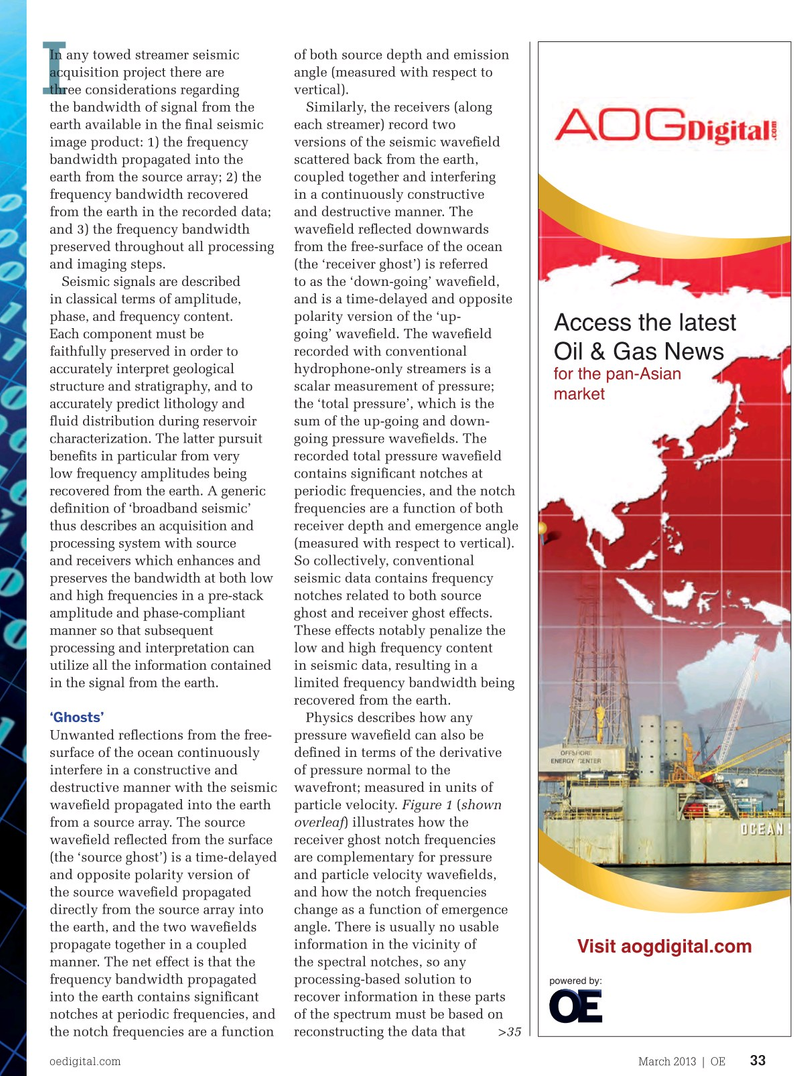
Page 31: of Offshore Engineer Magazine (Mar/Apr 2013)
Read this page in Pdf, Flash or Html5 edition of Mar/Apr 2013 Offshore Engineer Magazine
Geology & Geophysics
In any towed streamer seismic of both source depth and emission acquisition project there are angle (measured with respect to three considerations regarding vertical).
I the bandwidth of signal from the Similarly, the receivers (along earth available in the ? nal seismic each streamer) record two image product: 1) the frequency versions of the seismic wave? eld bandwidth propagated into the scattered back from the earth, earth from the source array; 2) the coupled together and interfering frequency bandwidth recovered in a continuously constructive from the earth in the recorded data; and destructive manner. The and 3) the frequency bandwidth wave? eld re? ected downwards preserved throughout all processing from the free-surface of the ocean and imaging steps. (the ‘receiver ghost’) is referred Seismic signals are described to as the ‘down-going’ wave? eld, in classical terms of amplitude, and is a time-delayed and opposite phase, and frequency content. polarity version of the ‘up-
Access the latest
Each component must be going’ wave? eld. The wave? eld faithfully preserved in order to recorded with conventional
Oil & Gas News accurately interpret geological hydrophone-only streamers is a for the pan-Asian structure and stratigraphy, and to scalar measurement of pressure; market accurately predict lithology and the ‘total pressure’, which is the ? uid distribution during reservoir sum of the up-going and down- characterization. The latter pursuit going pressure wave? elds. The bene? ts in particular from very recorded total pressure wave? eld low frequency amplitudes being contains signi? cant notches at recovered from the earth. A generic periodic frequencies, and the notch de? nition of ‘broadband seismic’ frequencies are a function of both thus describes an acquisition and receiver depth and emergence angle processing system with source (measured with respect to vertical). and receivers which enhances and So collectively, conventional preserves the bandwidth at both low seismic data contains frequency and high frequencies in a pre-stack notches related to both source amplitude and phase-compliant ghost and receiver ghost effects. manner so that subsequent These effects notably penalize the processing and interpretation can low and high frequency content utilize all the information contained in seismic data, resulting in a in the signal from the earth. limited frequency bandwidth being recovered from the earth.
‘Ghosts’ Physics describes how any
Unwanted re? ections from the free- pressure wave? eld can also be surface of the ocean continuously de? ned in terms of the derivative interfere in a constructive and of pressure normal to the destructive manner with the seismic wavefront; measured in units of wave? eld propagated into the earth particle velocity. Figure 1 (shown from a source array. The source overleaf) illustrates how the wave? eld re? ected from the surface receiver ghost notch frequencies (the ‘source ghost’) is a time-delayed are complementary for pressure and opposite polarity version of and particle velocity wave? elds, the source wave? eld propagated and how the notch frequencies directly from the source array into change as a function of emergence the earth, and the two wave? elds angle. There is usually no usable propagate together in a coupled information in the vicinity of
Visit aogdigital.com manner. The net effect is that the the spectral notches, so any frequency bandwidth propagated processing-based solution to powered by: into the earth contains signi? cant recover information in these parts notches at periodic frequencies, and of the spectrum must be based on the notch frequencies are a function reconstructing the data that >35 oedigital.com March 2013 | OE 33 oe_PGS_rev2.indd 33 27/02/2013 11:36

 30
30

 32
32